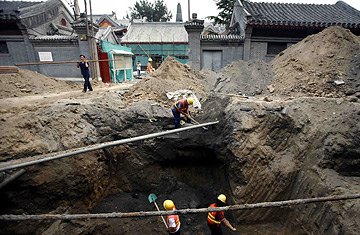
Workers dig a hole as a house is demolished along a Hutong, a traditional Chinese alleyway, in Beijing.
Xia Jie stands in the courtyard of her family's house in central Beijing, glancing up as a breeze flutters the leaves of a pomegranate tree. Except for the sounds of playing children in the alley outside, all is silence. "It's hard to believe we are in the center of a city of 15 million, isn't it?" she says. Hers is a traditional, single-story courtyard home in one of the city's ancient hutongs, the lanes that the city's Mongol designers intended as the heart of the metropolis when they planned it in 1272. There were once 6,000 hutongs in Beijing, but the tidal wave of change that has accompanied the city's explosive growth over the last two decades has swept most away. Today, fewer than 1,000 remain.
The pressure to modernize and the huge profits reaped by developers has overwhelmed efforts by preservationists and some bureaucrats to protect what was once one of the world's best-preserved medieval cities. Numerous stories that make it into China's tightly controlled media about collusion between city officials and developers testify to the fact that regulatory control of Beijing's redevelopment was, for a while, almost non-existent. Still, Xia Jie's house was supposed to be safe, because of its setting within the city's second ring road, which follows the route once marked by the capital's 30-feet high city walls.
In theory, hutongs inside the ring are strictly protected. But last May, developers suddenly appeared on Xia Jie's doorstep, knocking down two houses and issuing a notice for 23 households to move out. The city had given permission for the construction of a 12-story office building and an adjacent apartment block, the builders said. "It was so offensive," says Xia. "They gave us 14 days to move out. It's like being a second-class citizen in your own country." She says she spoke to the other residents and many of them agreed with her that there was no way they were going to move out.
Few observers would have given the Dongsibatiao residents much chance of winning their battle. More than 1 million Beijingers have already been relocated as the city prepares for the Olympics, and groups lobbing for preservation have had negligible success — except in drawing the unwelcome attention of China's vast security apparatus, which is notoriously suspicious of attempts to create independent organizations of any kind. In 2004, for example, housing rights activist Ye Guozhu — who had attempted to organize protest against forced evictions — was arrested and sentenced to four years in prison after being convicted of "disturbing social order."
Some Beijingers have reluctantly resigned themselves to the inevitability of change. "When I was a boy," says novelist Wang Shuo, celebrated chronicler of the life of ordinary Beijingers, "a group of Muslims lived near us around the Chaowen Gate, who had yellow hair and yellow eyes. They had been brought in by the Mongols when they came to Beijing, and lived together ever since. A thousand years. And then the whole place was demolished and they were scattered all over." Sitting in his house in a manicured suburb 20 miles from the city center, Wang shakes his head with resignation. "I never go into Beijing anymore. I don't recognize anything."
Still, signs are emerging that the tide may be turning for those fighting the Quixotic fight for preservation of old Beijing. On October 15, Beijing Communist Party Secretary Liu Qi said the city plans to invest 2 billion renminbi ($268 million) over the next few years to renovate courtyard houses to protect the city's cultural heritage, and also to raise the living standards of hutong residents through measures to improve housing, transportation, environment, education, food safety and social security. The change in official attitudes may also lead to a more tolerant response to citizens' efforts to prevent further destruction. In September, for example, monks managed to block city workers from demolishing part of the Fayuan Buddhist Temple, Beijing's oldest, built well over a thousand years ago during the Tang dynasty. Although there's some debate about what exactly the workers were doing, appeals by the monks brought speedy intervention by city authorities to cease the demolition.
Back at Dongsibatiao, Xia Jie says things have taken a surprising turn for the better since residents received their eviction notices in May. Xia says she confronted the developer and brought evidence that proper legal procedures hadn't been followed, arguing that the permission granted by the city government for the project was therefore invalid. Soon after, there was a sudden change of attitude. The range of the project was scaled back so that it will now involve a smaller, six-story building to be sited on the edge of the hutong. Other buildings taken over by the developer (at a price that is still being negotiated) will merely be renovated and remain traditional, single-story courtyards. "Now it's as though the developer wants to be my best friend," Xia says bemusedly. "He even invited me out to eat French cuisine!" Luckily for Xia, a growing number of Beijingers appear to be embracing the idea that even in the capital of the world's fastest-changing nation, some things are worth preserving.
